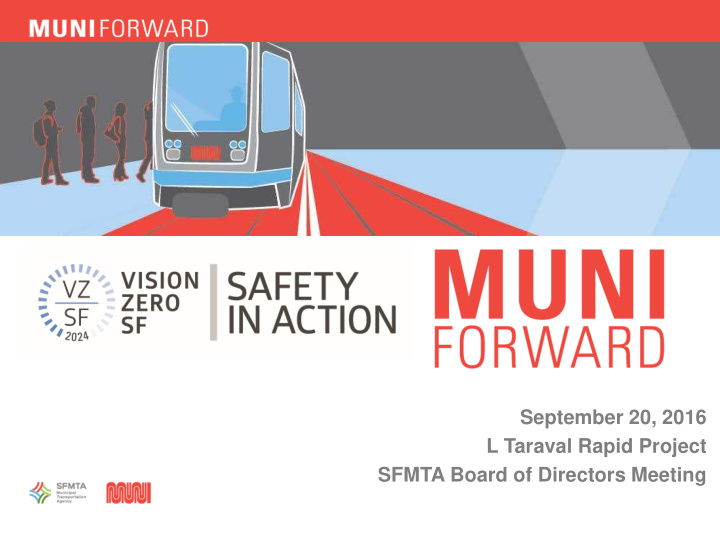



September 20, 2016 L Taraval Rapid Project SFMTA Board of Directors Meeting
WHY TARAVAL STREET
L TARAVAL PROJECT GOALS 1. Improve state of good repair of our transit system – Track and overhead replacement – Surface repaving – Water and sewer replacement – Curb ramp upgrades 2. Improve safety on Taraval – Prevent injuries, in support of Vision Zero 3. Improve transit reliability and comfort – Reduce long waits for the train
TEXTIZEN SURVEY: HOW IS THE L TREATING YOU?
PROPOSED SOLUTIONS » Boarding islands » Stop removal and relocation » T raffic signals » T ransit-only lanes » Pedestrian bulbs » R elocate and manage parking
DEVELOPING A SOLUTION WITH THE COMMUNITY » Pre-2014: Transit Effectiveness Project » March 4, 2014: Taraval-specific open house » March 28, 2014: TEP environmentally cleared, more detailed proposal developed for Taraval » September 2015: Focus group 1 and 2 » Oct 7, 2015: 1st open house » Nov 4, 2015 : “Pop-up” open house » Dec 14, 2015: 2nd open house » Feb 4, 2016: Walking tour » Feb 17, 2016: Third open house » April 13, 20, 27, 2016: Series of small group meetings with Taraval stakeholders » Summer 2016: Webinar, letter to 16,000 residents summarizing project » July 22, 2016: Public Engineering Hearing » Project survey taken by over 1,600 people
SUMMARY OF HOW COMMUNITY FEEDBACK SHAPED THE CURRENT PROPOSAL Element Original Proposal Revised Proposal Stop Remove 14 of 40 surface stops Remove 9 of 40 surface stops consolidation Traffic signals Up to 11 new signals 5 new signals (all replacing stop signs (including 4 at far-side stops) where trains don’t stop) Transit-only lane Implement in 2020 Early implementation; closely study effects on traffic and transit for 1 year Boarding islands Install at all L stops on Taraval Pilot (no parking moved) at 4 out of 5 (including 5 in each direction inbound stops near businesses. in business areas) Install islands at other stops. Parking One-for-one replacement of Original proposal + additional parking parking with angled parking management to create turnover for within a block of Taraval customers Additional accessible platforms at 30 th Accessibility New accessible platforms at (28 th inbound) 19 th , 42 nd
PR O JE C T G O AL: IMPR O VE SAF E TY » T araval is on the Vision Zero High Injury Network » In the past 5 years, 46 pedestrians have been hit » 22 of those hit were getting on or off the train Reported Pedestrian Injury Collisions on T araval Street, 2009-2013
PROPOSED SAFETY IMPROVEMENTS: BOARDING ISLANDS Giving riders a place to stand Boarding islands provide transit riders a Taraval/23 rd Ave. boarding island safe place to get on and off the train, and will eliminate most collisions. Judah Street boarding island
OTHER SAFETY IDEAS WE’VE HEARD • Enforcement – More police enforcement – Video enforcement • Upgrades to trains – Upgraded signage on trains – Stop sign and stop arm on trains (similar to school buses) – Warning lights mounted to outside of trains • Changes to street – Railroad-style crossing arms on Taraval – More signage and/or painted treatment on street • Education – Flyers and posters at businesses
LOADING ZONE EVALUATION
EARLY IMPLEMENTATION OF CLEAR ZONES
STOP SPACING COMPARISON Average Stop Spacing: 15th Ave. to 46th Ave. 1,200 1,000 Min. spacing for surface rail per SFMTA guidelines Average Distance Between Stops (Feet) 900 800 600 400 200 0 L (existing) L (proposed) N 5 (local) 38 (local) SFMTA stop spacing standard for surface rail: 900-1,500 feet
RELIABILITY IMPROVEMENT: STOP CONSOLIDATION Updated Proposal Based on Stakeholder Input (green circles are restored stops) SFMTA stop spacing standard for surface rail: 3-5 blocks (Sunset east-west blocks)
RELIABILITY IMPROVEMENT: TRANSIT-ONLY LANES • Gives trains a dedicated lane to ensure more reliable travel times. • Cars can enter lane to make left turns and pass double-parked vehicles.
TODAY’S LEGISLATION Pedestrian safety – Establish 14 transit boarding islands (5 of these would not be installed if loading zone evaluation successful) – Extend 4 existing transit boarding islands – Establish 2 transit bulbs – Establish 11 pedestrian bulbs – Establish left turn restriction at Sunset Blvd Transit reliability – Establish transit-only lanes – Establish 5 traffic signals – Remove 9 stops (4 inbound, 5 outbound) – Optimize 1 stop location
NEXT STEPS • Legislation at SFMTA Board – today • Early Implementation – January 2017 – Transit-only lane (stencil only; not red) – Stop consolidation – Pilot treatment at 5 stops – Striped boarding clear zones at all other stops • Pilot evaluation period – first 6 months of 2017 • Full project construction: Feb 2018-Feb 2021 – Bus substitution fall 2019 – Feb 2021 (18 months)
Recommend
More recommend